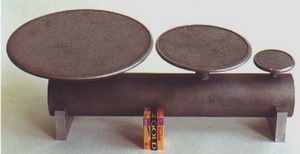Main Sector of relevance\IRC classification 7. Environment and Safety
7.12 The aerator of standard size 3 on the air transfer duct

Developers’ contact information
State Scientific Institution “The Powder Metallurgy Institute of the National Academy of Sciences of Belarus”
41 Platonov Street, Minsk BY-220005
Summary
It is necessary to mix service-utility and industrial wastes in
order to provide their biological treatment in order to prevent the system from
still water evolution and homogenization of muddy material flocks mixture with
effluents as well as to melt down oxygen there in order to provide the life
activity of aerobian bacteria and microorganisms. Both functions are fulfilled
by the airing systems of various types, among which pneumatic aeration systems
with porous elements - aerators of various forms - pipes, plates, disks of
various diameter – are most effective. Oxygen dissolving intensification is
achieved by artificial surface extend of liquid-gas contact via fine
dispergation of one of the phases, in this particular case – of the gas
phase. Air or another gas dispergation in water is carried out with the help of
porous aerators placed at the depth where gas is input.
Upon final purification and decontamination of water by ozonation, the
ozonic-airy mixture is also added into water through porous dispergators. As
per corrosion stability, long-time strength, recoverability and airing
effectiveness, the expanded materials (that were produced using powder
metallurgical techniques) excel textiles, meshes, felted fabrics, perforated
metal and polymeric sheets.
The aerators for dispergation of air, ozone, oxygen and other process gases in
catalyst chambers of drinking and waste water ozonation, in flotation and
oxytanks, aerotanks of biological treatment effluents are proposed for
production under this project.
The aerator includes a porous disk that is fixed and tightened in the body
frame by means of curling or welding; the body frame is attached to the
positive pressure system by nose piece welded at the bottom of it (the box
thread of the nose piece is 3/4”). Dispergator may be of three dimensions and
may have disks of various areas.
Operating principle: generation of small bubble by particular disk pores (the
pore area is at least 50% of the disk area, pores can be of different size from
5 to 150 micrometers).
Advantages over analogues: high performance reliability and long-term service
life (over 10 years in some facilities) without repairs and renewals; repeated
recoverability; less water resistance and bigger oxygen utilization
coefficient, which makes it possible to lessen gas supply by 15-20%, reduce
compressor power consumption and power consumption.
Description
The aerators for dispergation of air, ozone, oxygen and other process gases in catalyst chambers of drinking and waste water ozonation, in flotation and oxytanks, aerotanks of biological treatment effluents are proposed for production under this project. The technology includes porous aerator disk formation from metallic powder, porous disk sintering, aerator body frame production, porous disk curling in the aerator body frame.
Technology type
Technical advantages and economic benefits
Designation: dispergation of air, ozone, oxygen and other process
gases in water.
Scope of application: municipal and industrial systems of water conditioning
and effluent treatment, biochemical industry, food industry, etc.
Advantages over analogues: high performance reliability and long-term service
life without repairs and renewals (over 10 years); the possibility of repeated
recoverability; less water resistance and bigger oxygen utilization
coefficient.
Technology differentiation and uniqueness
Less water resistance and bigger oxygen utilization coefficient
make it possible to lessen gas supply by 15-20%, reduce compressor power
consumption and power consumption.
Aerator construction design Type UV is protected by the USSR certificate of
authorship No. 1632951 and by two patents of the Republic of Belarus.
Context in which technology was identified
“The week high technology in St. Petersburg”, the 6-th and
8-th International Exhibitions, 2001 and 2003;
9-th, 10-th, 11-th International Specialized Exhibitions “Metal powder
industry - 2003, 2005, 2007”
Technological keywords
Water conditioning, airing, ozonation, treatment of drinking, industrial and effluent water.
Development Stage
Intellectual property rights
Range of applications
Energy industry
Environmental security and protection
Industrial production, materials and transport.
Classifier Used at the EU Innovation Relay Centres
Preferable Regions
Practical experience
Primary consumers: drinking water treatment - treatment water
supply plant Production Association “Minskvodokanal” (1987, 2001, 2008),
Eastern water supply plant Production Association “Mosvodokanal” (1994),
the development centre of Traeligaz Company, France (1997);
Biochemical effluent treatment – Ivano-Frankovsk plant of fine organic
synthesis (1989); Production Association “Ivano-Frankovskkanal” (1990),
Ust-Kamenogorsk cement plant (1992); Kemerov anilino-ink plant (1993);
Production Association “Krasnoyarskvodokanal” (1996-1997);
separation of oil product films and slurries in effluent waters: ecological
plant “Koalestsent”, Sevastopol (1992-1996).
Environmental impact
The proposed techniques and equipment have no negative environmental influence, they are environmentally friendly and are destined for human health protection and environment protection.
Type of collaboration sought
Terms and restrictions
None.
Available technical assistance